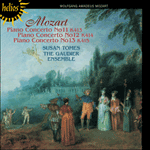The Concerto in A major, K414 impresses with its lyricism and rich melodic texture, especially in the first movement: the ritornello presents four different themes, the solo-piano elaborates with the addition of two more. Particularly the transitions between the individual parts are of expert design; a wonderful balance carries the musical progression without ever depending on dramatic effects. In the second movement, a solemn ‘andante’, Mozart emulates his great idol Johann Christian Bach, who had died the year before. As if paying a personal homage, he takes the first four bars of an overture that Bach had composed in 1763 for Baldassare Galuppi’s opera
La Calamità dei Cuori and respectfully adapts them for his main theme. Mozart had originally envisioned the ‘Rondo’ in A major, K386 for the finale of this concerto, but this posthumously published piece had to give way to a more compact final movement. Its playful main theme exemplifies how Mozart was able to write catchy and easily understandable themes, as he had alluded to in his letter. Only the central part of the movement contains flickering moments of operatic drama, the rest is pure pleasure of the highest order.
from notes by Gottlieb Wallisch © 2013
Das Konzert in A-Dur, KV 414 besticht durch seinen lyrischen Charakter und reiche Melodik, insbesondere im Kopfsatz: Das Ritornell präsentiert vier verschiedene Themen, das Klavier fügt diesen dann noch zwei weitere neue Melodien hinzu. Besonders die Übergänge zwischen den einzelnen Teilen sind meisterhaft gestaltet, eine wunderbare Balance trägt das gesamte musikalische Geschehen, ohne je nach dramatischen Effekten zu suchen. Im zweiten Satz, einem feierlich-würdevollen andante, besinnt sich Mozart seines großen Vorbilds Johann Christian Bach, der ein Jahr zuvor verstorben war. Einer Hommage gleich übernahm er als Hauptthema nahezu unverändert die ersten vier Takte einer ouvertüre, die Bach 1763 für Baldassare Galuppis oper
La Calamità dei Cuori komponiert hatte. Für das Finale dieses Konzerts hatte Mozart ursprünglich das nach seinem Tod erschienene Konzertrondo in A-Dur, KV 386 vorgesehen. Es musste aber einem knapperen Schlusssatz weichen. Dessen pfiffiges Hauptthema macht deutlich, welch eingängige und leicht verständliche Themen Mozart schreiben konnte, auf die er in seinem Brief anspielte. nur im Mittelteil des Satzes flackern Momente opernhafter Dramatik auf, der Rest ist reines Vergnügen auf höchstem niveau.
aus dem Begleittext von Gottlieb Wallisch © 2013


 Mozart: Piano Concertos Nos 11, 12 & 13
Mozart: Piano Concertos Nos 11, 12 & 13
